Starpeople: The milky way…

Check out Chris’ pictures!

Check out Chris’ pictures!
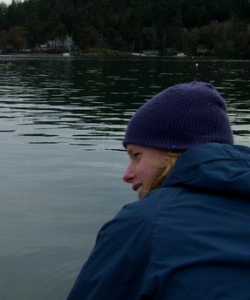
One of the awesome things about living in a small community on a small island with small numbers of people with large hearts is the wonderful gifts we give each other.
On San Juan Island off the coast of Washington (the state, not the city) & just across the water from Victoria (the city, not the queen), lives my good & dear friend Ryan Browne, who shared this little tale about something he discovered when he came rolling home one day. While I’m pretty sure “Thoreau” is a metaphorical nom d’plume here (pretty sure he didn’t know about plastic bowls), it’s a sweet bit of writing for Ryan, who I think of as a modern-day Thoreau, in his own right.
Here’s more, from Ryan:
Sorry this took so long to write…
To the anonymous person who left this Thoreau poem, handwritten on a cedar shingle on my kitchen counter months ago: YOU are the BEST kind of person..
You truly made my day, and have done so each and every time that I look upon this poem. (which is now hanging in my kitchen).
You inspire me to pay it forward – to take a little bit of time out of each day to give appreciation, thoughtfulness, and inspiration to others, while expecting nothing in return. It’s these little things in life that give me sustenance while this beautiful, crazy planet seems to be spinning so fast.
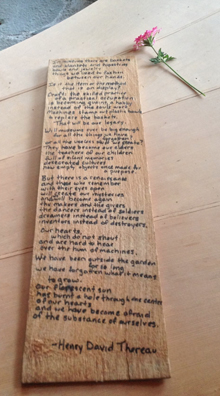
Whoever you are, keep on shining, you wonderful human.. The world needs you now more than ever.
In museums there are baskets
and blankets and tapestries
bowls and jewelry
things we used to fashion
between our hands.
Is it the item or the method
that is on display?
Craft: The skilled practice
of a practical occupation
is becoming quaint. A hobby
instead of the soul’s work.
Machines stamp out plastic bowls
to replace the baskets.
That will be our legacy.
Will museums ever be big enough
for all the things we have forgotten?
Or all the useless stuff we create?
They have become our elders
the teachers of our children
full of silent memories
desecrated cultures
now empty objects once made for a purpose.
But there is a renaissance
and those who remember
with their eyes open
will create our mysteries
and we will become again
the makers and the givers
the dancers instead of soldiers
dreamers instead of believers
inventors instead of destroyers.
Our hearts,
Which do not shout
And are hard to hear
over the hum of machines.
We have been outside the garden
for so long
We have forgotten what it means
to grow.
Our florescent sun
has burned a hole through the center
of our hearts
and we have become afraid
of the substance of ourselves.
Henry David Thoreau (sic)
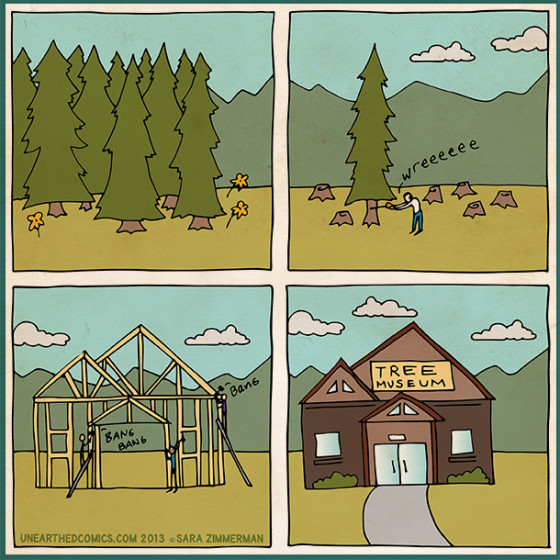
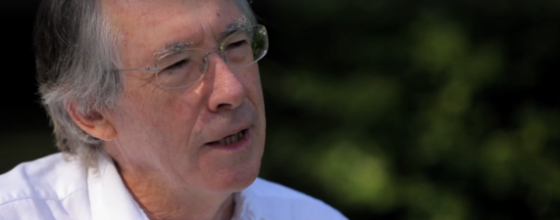
In this video from Aero Gramme Writers’ Studio, Ian McEwan discusses writing about love, in fiction:
“It’s very difficult to do happiness in novels in a sustained way.”
In this video recorded by the Louisiana Museum of Modern Art earlier this year, Ian McEwan reflects on making romantic love work in fiction, the amazing evolution of the novel as a genre, and the mature writer as a toddler of old age.
Ian McEwan has been nominated for the Man Booker Prize six times, winning the prize in 1998 for Amsterdam. His most recent novel, Sweet Tooth, was published in 2012.
I know you’ve heard this song by Nanci, but have you heard it with Julie, who wrote it? Check it out….
The other day my friend Nalalie sent this over, when someone one asked, “How come people put their hands together & bow to each other?” Good start – there’s a bit more to it than that! Here’s a little explanation, if you were wondering:

NAMASTE, Friends..! :
Why do we do Namaste?
Indians greet each other with namaste. The two palms are placed together in front of the chest and the head bows whilst saying the word namaste. This greeting is for all – people younger than us, of our own age, those older than friends, even strangers and us.
There are five forms of formal traditional greeting enjoined in the shaastras, of which namaskaram is one. This is understood as prostration but it actually refers to paying homage as we do today when we greet each other with a namaste.
Namaste could be just a casual or formal greeting, a cultural convention or an act of worship. However there is much more to it than meets the eye. In Sanskrit namah + te = namaste. It means – I bow to you – my greetings, salutations or prostration to you. Namaha can also be literally interpreted as “na ma” (not mine). It has a spiritual significance of negating or reducing one’s ego in the presence of another.
The real meeting between people is the meeting of their minds. When we greet another, we do so with namaste, which means, “may our minds meet,” indicated by the folded palms placed before the chest. The bowing down of the head is a gracious form of extending friendship in love and humility
The spiritual meaning is even deeper. The life force, the divinity, the Self or the Lord in me is the same in all. Recognizing this oneness with the meeting of the palms, we salute with head bowed the Divinity in the person we meet. That is why sometimes, we close our eyes as we do namaste to a revered person or the Lord – as if to look within. The gesture is often accompanied by words like “Ram Ram,” “Jai Shri Krishna”, “Namo Narayana”, “Jai Siya Ram”, “Om Shanti” etc – indicating the recognition of this divinity.
When we know this significance, our greeting does not remain just a superficial gesture or word but paves the way for a deeper communion with another in an atmosphere of love and respect.
Keshav Pandit
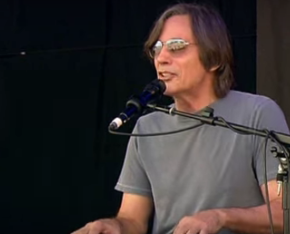
Turn off the other stuff & give this a listen, you’ll be glad you did.
When Jackson sings this song from the mid-1970s (recorded here in 2010 at the UK’s Glastonbury Festival), it echoes the hopes & fears we struggle with today, as he sings in the third verse:
Some of them were angry
At the way the earth was abused
By the men who learned how to forge her beauty into power
And they struggled to protect her from them
Only to be confused
By the magnitude of her fury in the final hour
And when the sand was gone and the time arrived
In the naked dawn only a few survived
And in attempts to understand a thing so simple and so huge
Believed that they were meant to live after the deluge
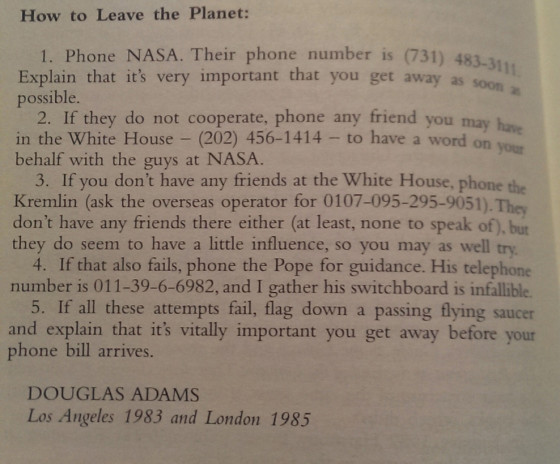
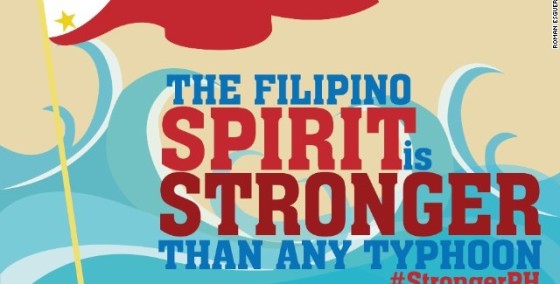
Just asked my dear friend Lolit in the Philippines what I could post, for my circle of folks who might want to help (from all over the world, so it’s a bit of a wide-spread circle)…she suggested this local (there) site, with lots of options (including good wishes & prayers) to give, to share, to heal…..and she keeps telling me folks there are pulling together to help one another, and are pretty fired up to get on top of this:

Seems to me that it’s something everyone struggles with – finding the wellspring of love & devotion & allowing for a natural & easy flow, without shaping that flow with a litany of “you should,” “you should,” and “you really should!” Steven suggests a way to move forward while being gentle with your evolving spirit:
The Importance of Taking the “Should” out of Spiritual Practice
by Steven Goodheart (here’s more)
The more one does one’s spiritual practice with a sense that it should be done, the more one creates a sense of self. And the greater the sense of a self trying to become “spiritual” or “liberated,” the more suffering we experience. We suffer both when we “fail,” and we suffer when we “succeed,” either way reinforcing our false self-identifications.

So the koan is: how do we practice, without making it “practice?” How can one have what the Buddha called atappa, or ardency in practice, without reinforcing our sense of becoming? The answer to this koan involves, perhaps not surprisingly, paying attention ― paying real attention to our motives and to our habitual ways of doing anything worthwhile.
Paradoxically, real “self-improvement” naturally arises when we let go of all sense of self-improvement and simply open ourselves up to being really being present in each moment. There is a wonderful innocence in simply being present in the moment. There is great purity in simply paying attention of what is arising as simply what is arising, and then acting, or not acting, according to our best sense of wisdom, compassion, and insight into what is skillful and what is not, what produces suffering and what does not.
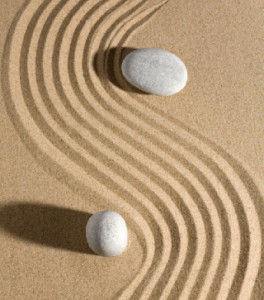
When we do this, we are not trying to “improve,” or “be a better person” so much as making the right effort to see what is good and wise in the present moment.
When we get busy with being present, when we really pay attention to what arises in our hearts and minds, our sense of self naturally just falls away. We become, in the degree of our attention, an action without an actor, a doing without a doer. One doesn’t cease to be; one simply is. We get glimpses of this when we become fully absorbed in something, or “in the flow of things,” and no thought of self arises or can be found. But mindful attention is even better than absorption, which can make us oblivious to anything but what we are focusing on.
With mindful attention, the sense of self falls away and we are fully aware of what’s going on without attaching to or clinging to sense contacts or to thoughts and feelings that arise and fall away.
The simplicity of this paying attention practice that is not practice is staggering, once you begin to understand it. You don’t have to be sitting on a cushion to pay attention, though that’s a good place to practice it formally. Each moment of our day is an opportunity to show up ― to be consciously present and aware. So much of the time we are so lost in thoughts, feelings, ruminations, and internal dialogues that we are not really alive, but just existing in a self-dream.

Truly paying attention breaks the spell of “self” and helps us to stop “self-ing” and start “be-ing.” It helps us see our connections and relationships to others and to all things. We feel our true wholeness.
Living this way, “How do I make myself better?” isn’t even the question; the very thought of “self-improvement” is actually an impediment. The real question is: Do I want to be alive? The issue is waking up, showing up, being present. There is no “should” or “must” in waking up! All beings naturally want happiness, and when we realize that we are truly happy to the degree we are truly present with our hearts and minds, then nothing can keep us from opening up.
Mindful attention is like sunlight, shedding light on what is dark and hidden and causing all the good things of our hearts to blossom and bloom into the possibilities of full being. There’s nothing we have to do to make this happen; it just happens when we show up each day, each moment, with no thought of self, but simply wanting to see what is what—as much as possible, without delusion, illusion or self-deception about anything. Yes, it’s a great work, but it’s such a freeing, happy one!
And it all starts in a moment, this moment.
Why not begin?

In the lore of monkish tales, most know the story of the original Francesco, who said that his conversion to a life of faith came along after he had embraced & kissed a leper.
This past week, the pope for our Roman Catholic friends echoed his thirteenth century namesake as a photo went viral ’round the world of him embracing a fellow with neurofibromatosis, a condition which has left him with tumors all over his body & face.
I love it when a good idea gets good press.
It’s tempting to look at the picture & say how cool the pope is for doing this. (And, it is cool.) It’s also tempting to leave the inspiration, the lesson & the discussion there.
But the more interesting question is: Have you kissed your leper today? What or who is in your life that you shun, because you’ve decided they’re gross? Can you close your eyes to the tumors & open your heart to the warmth of someone whose healing begins with your touch?
Now that would be cool.
Love you & the way you do,
Brother Ian

Most of my steady readers from the San Juan Islands know that the past week has seen the cutting of one of the Internet & phone cables in the islands, leaving many islanders scrambling to connect with each other.
Islander (and former judge) Glenna Hall’s remarks about this have been published in The Atlantic. See what you think.